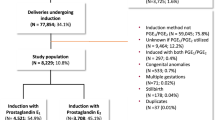Abstract
Objective:
To compare time to delivery between two induction procedures. The Foley balloon is a mechanical method for cervical ripening. However, the device may also result in endogenous prostaglandin release following separation of the chorionic membrane and decidua. Prolonged Foley placement may therefore be unnecessary for successful labor induction.
Method:
Randomized controlled trial of labor induction at LAC+USC Medical Center between 2010 and 2013. Subjects were assigned to either (a) standard placement of the Foley balloon or (b) Foley balloon insufflation and immediate removal. Oxytocin was administered to all subjects not in active labor after 12 h. Delivery information and neonatal outcomes were documented and all patients were followed for 6 weeks for adverse events.
Result:
A total of 79 women were included in the analysis (37 standard and 42 immediate). Induction time was 8.6 h longer in the immediate removal group (23.5 vs 32.1, P=0.002), but the difference in delivery within 24 h did not meet the statistical significance (46.0 vs 28.6%, P=0.11). Similar rates of cesarean delivery, epidural use and abnormal APGAR scores were observed. After controlling for number of vaginal exams and duration of rupture, a decreased risk of infection was observed in the immediate removal group (odds ratio=0.08, 95% confidence interval=0.007 to 0.93, P=0.04). Further, when the analysis was stratified by parity, differences in induction time only persisted in nulliparous women.
Conclusion:
Immediate removal of the Foley balloon may lead to longer overall induction time, but a lower risk of infection. Parous women may be particularly good candidates for this type of induction.
This is a preview of subscription content, access via your institution
Access options
Subscribe to this journal
Receive 12 print issues and online access
$259.00 per year
only $21.58 per issue
Buy this article
- Purchase on Springer Link
- Instant access to full article PDF
Prices may be subject to local taxes which are calculated during checkout




Similar content being viewed by others
References
Martin JA, Hamilton BE, Ventura SJ, Osterman MJ, Mathews TJ . Births: final data for 2011. Natl Vital Stat Rep 2013; 62 (1): 1–69, 72.
Jozwiak M, Bloemenkamp KWM, Kelly AJ, Mol BWJ, Irion O, Boulvain M . Mechanical methods for induction of labour. Cochrane Database Syst Rev 2012; (3): CD001233.
Manabe Y, Manabe A, Takahashi A . F prostaglandin levels in amniotic fluid during balloon-induced cervical softening and labor at term. Prostaglandins 1982; 23 (2): 247–256.
Sciscione AC, Nguyen L, Manley J, Pollock M, Maas B, Colmorgen G . A randomized comparison of transcervical Foley catheter to intravaginal misoprostol for preinduction cervical ripening. Obstet Gynecol 2001; 97 (4): 603–607.
Pettker CM, Pocock SB, Smok DP, Lee SM, Devine PC . Transcervical Foley catheter with and without oxytocin for cervical ripening: a randomized controlled trial. Obstet Gynecol. 2008; 111 (6): 1320–1326.
Boulvain M, Kelly A, Lohse C, Stan C, Irion O . Mechanical methods for induction of labour. Cochrane Database Syst Rev 2001; Cd001233.
Jozwiak M, Bloemenkamp KW, Kelly AJ, Mol BW, Irion O, Boulvain M . Mechanical methods for induction of labour. Cochrane Database Syst Rev 2012; 3: Cd001233.
Kelly AJ, Tan B . Intravenous oxytocin alone for cervical ripening and induction of labour. Cochrane Database Syst Rev 2001; Cd003246.
Levy R, Kanengiser B, Furman B, Ben Arie A, Brown D, Hagay ZJ . A randomized trial comparing a 30-mL and an 80-mL Foley catheter balloon for preinduction cervical ripening. Am J Obstet Gynecol 2004; 191 (5): 1632–1636.
Kashanian M, Nazemi M, Malakzadegan A . Comparison of 30-mL and 80-mL Foley catheter balloons and oxytocin for preinduction cervical ripening. Int J Gynaecol Obstet 2009; 105 (2): 174–175.
Delaney S, Shaffer BL, Cheng YW, Vargas J, Sparks TN, Paul K et al. Labor induction with a Foley balloon inflated to 30 mL compared with 60 mL: a randomized controlled trial. Obstet Gynecol 2010; 115 (6): 1239–1245.
Ghezzi F, Massimo F, Raio L, Di Naro E, Balestreri D, Bolis P . Extra-amniotic Foley catheter and prostaglandin E(2) gel for cervical ripening at term gestation. Eur J Obstet Gynecol Reprod Biol 2001; 97 (2): 183–187.
Chung JH, Huang WH, Rumney PJ, Garite TJ, Nageotte MP . A prospective randomized controlled trial that compared misoprostol, Foley catheter, and combination misoprostol-Foley catheter for labor induction. Am J Obstet Gynecol 2003; 189 (4): 1031–1035.
Heinemann J, Gillen G, Sanchez-Ramos L, Kaunitz AM . Do mechanical methods of cervical ripening increase infectious morbidity? A systematic review. Am J Obstet Gynecol 2008; 199 (2): 177–187 discussion 187–188.
Karjane NW, Brock EL, Walsh SW . Induction of labor using a foley balloon, with and without extra-amniotic saline infusion. Obstet Gynecol 2006; 107 (2 Pt 1): 234–239.
American College of Obstetricians and Gynecologists (College) Society for Maternal-Fetal Medicine: Caughey AB, Cahill AG, Guise JM, Rouse DJ . Safe prevention of the primary cesarean delivery. Am J Obstet Gynecol 2014; 210 (3): 179–193.
Sciscione AC, Muench M, Pollock M, Jenkins TM, Tildon-Burton J, Colmorgen GH . Transcervical Foley catheter for preinduction cervical ripening in an outpatient versus inpatient setting. Obstet Gynecol 2001; 98 (5 Pt 1): 751–756.
Author information
Authors and Affiliations
Corresponding author
Ethics declarations
Competing interests
The authors declare no conflict of interest.
Rights and permissions
About this article
Cite this article
Sharma, K., Grubbs, B., Mullin, P. et al. Labor induction utilizing the foley balloon: a randomized trial comparing standard placement versus immediate removal. J Perinatol 35, 390–395 (2015). https://doi.org/10.1038/jp.2014.229
Received:
Revised:
Accepted:
Published:
Issue Date:
DOI: https://doi.org/10.1038/jp.2014.229



